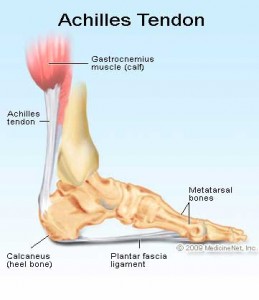Lesions of the Achillies Tendon or Calf Muscle
Achillies Tendonitis
 Achilles tendonitis is a common condition affecting the Achilles tendon. It can be precipitated by inappropriate shoe wear or may appear spontaneously. It causes symptoms of pain and swelling in the Achilles tendon made worse by activity. Non-operative treatment initially would consist of rest and abstinence from rigorous physical activity and the use of ice and oral non-steroidal anti-inflammatory analgesia. If this fails to alleviate the symptoms, physiotherapy is a useful method in controlling the symptoms. Should such measures fail the limited use of the local instillation of cotico-steroids into the tendon sheath may alleviate symptoms. A recent development has been the use of Dolorcast high frequency energy waves in the treatment of such conditions. Results indicate a positive response in 65% of patients who have failed to respond to other measures. If all non-operative measures fail in resolving such symptoms, surgical decompression of the tendon sheath can be used. This is normally followed by a four week period of immobilisation in a plaster cast followed by physiotherapy.
Achilles tendonitis is a common condition affecting the Achilles tendon. It can be precipitated by inappropriate shoe wear or may appear spontaneously. It causes symptoms of pain and swelling in the Achilles tendon made worse by activity. Non-operative treatment initially would consist of rest and abstinence from rigorous physical activity and the use of ice and oral non-steroidal anti-inflammatory analgesia. If this fails to alleviate the symptoms, physiotherapy is a useful method in controlling the symptoms. Should such measures fail the limited use of the local instillation of cotico-steroids into the tendon sheath may alleviate symptoms. A recent development has been the use of Dolorcast high frequency energy waves in the treatment of such conditions. Results indicate a positive response in 65% of patients who have failed to respond to other measures. If all non-operative measures fail in resolving such symptoms, surgical decompression of the tendon sheath can be used. This is normally followed by a four week period of immobilisation in a plaster cast followed by physiotherapy.
Partial Tears
Partial tears of the musculo-tendinous junction of the tendo-achillies are sometimes seen in the slightly older and not necessarily sporty individual. The presentation is one of swelling and pain in the calf, which appears acutely. This maybe associated with bruising. This condition needs to be differentiated from other conditions such a ruptured Bakers Cyst and acute Deep Vein Thrombosis (DVT). Patients with such symptoms need to be assessed acutely and the necessary investigations and treatment need to be carried out expeditiously to exclude a DVT.
Rupture (Tear) of The Achillies Tendon
A rupture of the achillies tendon (TA) is a not infrequent injury and is classically seen in the sporty individual. It can occur during sport and when the tendon ruptures or tears completely. The patient classically describes a sensation of being hit across the back of their lower leg associated with a snapping sound. In sporty individuals, the surgeons preferred method of treatment is to repair the tendon surgically.
This is carried out under a general anaesthetic and the two ends of the tendon are brought together under appropriate tension. The foot is placed in a plaster cast from the metatarsals to below the knee in an equines position (ballerina on tiptoes). The plaster cast is gradually brought up to a neutral position over a period of some eight to nine weeks and physiotherapy is required thereafter. Vigorous sporting activities where pushing off of the forefoot need to be avoided for some three months following release from the plaster cast. Once the tendon has fully repaired the individual can return to all their previous level of physical activity.
A complete tear of the tendo-achillies can also be managed without surgery depending on the patients level of activity. The foot and ankle are placed in an equinuus (ballerina position) plaster cast for nine to ten weeks.
However, the ideal method of treatment for the individual needs of active patients should be discussed with your surgeon. There are risks and benefits to any form of treatment and the treatment should be aimed towards providing the best outcome for the individual patient. Failure to treat this condition can lead to weakness in foot and ankle movement.